ENV616 Assignment 3: Espoo Convention Policy Evaluation Report
VerifiedAdded on 2022/10/18
|12
|3305
|21
Report
AI Summary
This report evaluates the Espoo Convention, an environmental policy originating from the Stockholm declaration, focusing on its application in India's transboundary environmental concerns. The report begins with a background of the Espoo policy, emphasizing its role in Environmental Impact Assessment (EIA) and its evolution. It details the EIA process in a transboundary context, outlining the instruments and mechanisms involved, including notification, documentation, and consultation. The scope of the Espoo Convention in Indian law is analyzed, particularly in the context of the Environmental Assessment Notification of 2006 and its impact on transboundary EIA. The report then critically evaluates the policy, highlighting its strengths, such as public transparency and early planning, and challenges like public consultation limitations. It also examines the performance of the Espoo Convention, the integration of science into the policy, and the impact of the Indus Water Treaty. Overall, the report provides an in-depth analysis of the Espoo Convention's effectiveness and potential for improvement in addressing transboundary environmental issues.
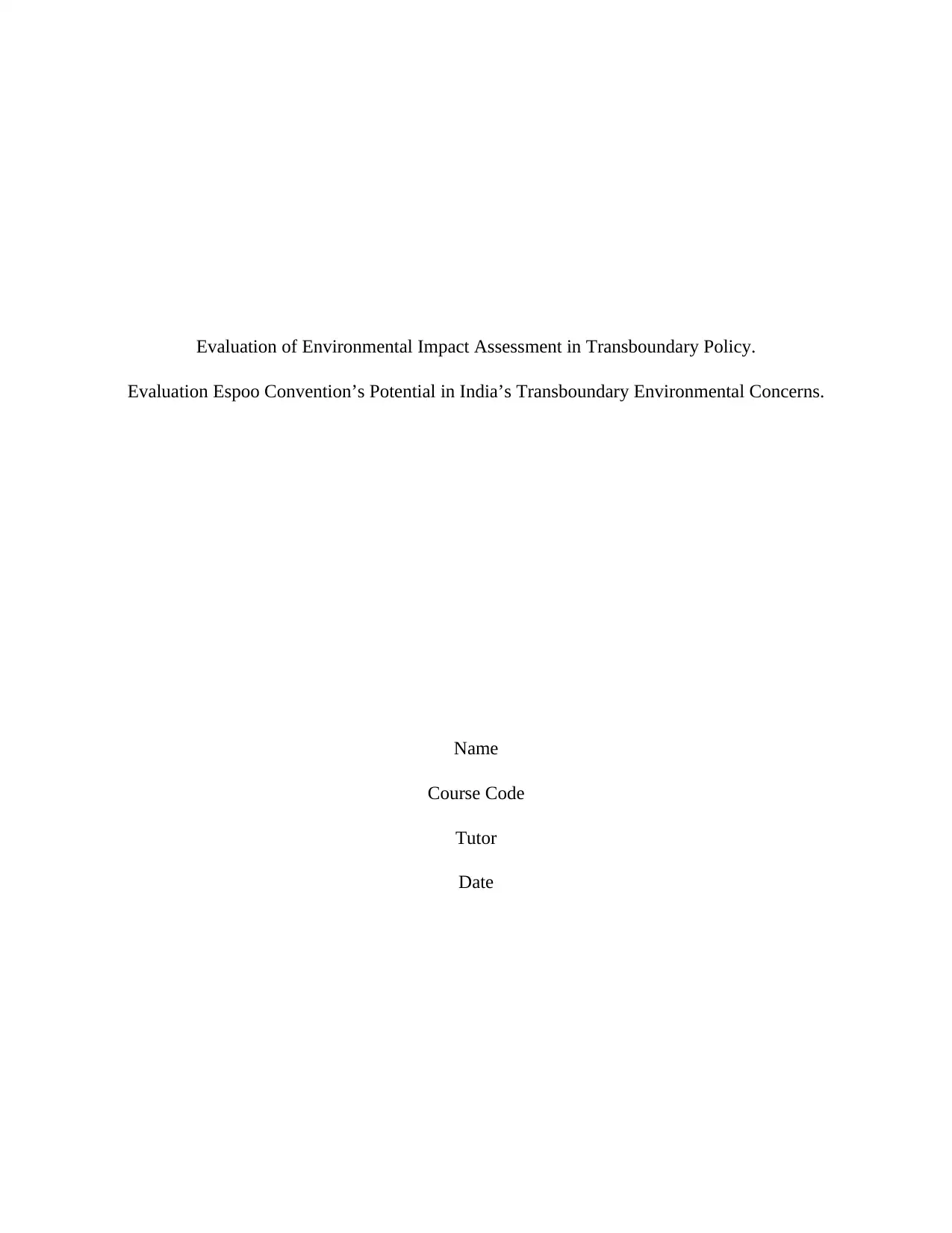
Evaluation of Environmental Impact Assessment in Transboundary Policy.
Evaluation Espoo Convention’s Potential in India’s Transboundary Environmental Concerns.
Name
Course Code
Tutor
Date
Evaluation Espoo Convention’s Potential in India’s Transboundary Environmental Concerns.
Name
Course Code
Tutor
Date
Paraphrase This Document
Need a fresh take? Get an instant paraphrase of this document with our AI Paraphraser
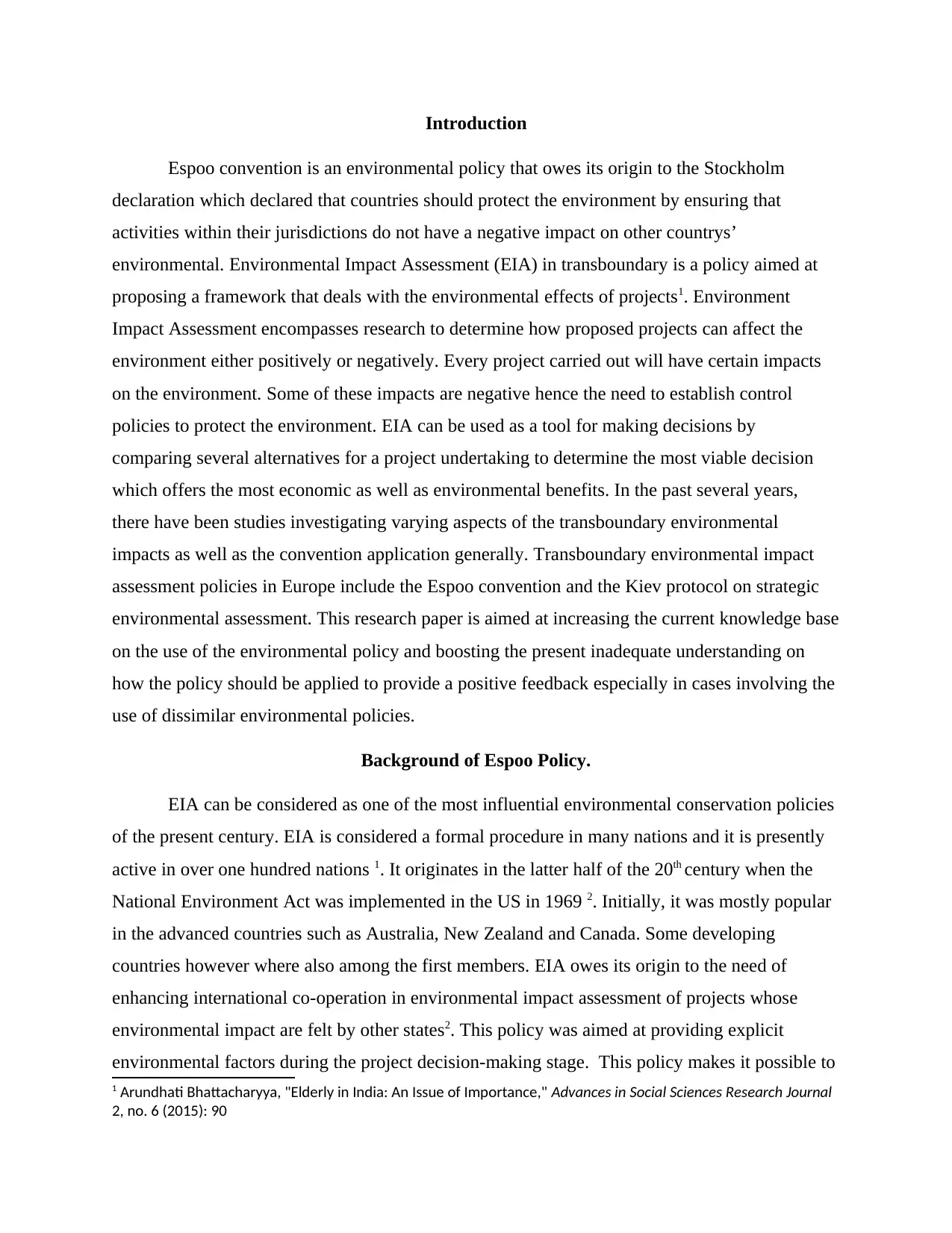
Introduction
Espoo convention is an environmental policy that owes its origin to the Stockholm
declaration which declared that countries should protect the environment by ensuring that
activities within their jurisdictions do not have a negative impact on other countrys’
environmental. Environmental Impact Assessment (EIA) in transboundary is a policy aimed at
proposing a framework that deals with the environmental effects of projects1. Environment
Impact Assessment encompasses research to determine how proposed projects can affect the
environment either positively or negatively. Every project carried out will have certain impacts
on the environment. Some of these impacts are negative hence the need to establish control
policies to protect the environment. EIA can be used as a tool for making decisions by
comparing several alternatives for a project undertaking to determine the most viable decision
which offers the most economic as well as environmental benefits. In the past several years,
there have been studies investigating varying aspects of the transboundary environmental
impacts as well as the convention application generally. Transboundary environmental impact
assessment policies in Europe include the Espoo convention and the Kiev protocol on strategic
environmental assessment. This research paper is aimed at increasing the current knowledge base
on the use of the environmental policy and boosting the present inadequate understanding on
how the policy should be applied to provide a positive feedback especially in cases involving the
use of dissimilar environmental policies.
Background of Espoo Policy.
EIA can be considered as one of the most influential environmental conservation policies
of the present century. EIA is considered a formal procedure in many nations and it is presently
active in over one hundred nations 1. It originates in the latter half of the 20th century when the
National Environment Act was implemented in the US in 1969 2. Initially, it was mostly popular
in the advanced countries such as Australia, New Zealand and Canada. Some developing
countries however where also among the first members. EIA owes its origin to the need of
enhancing international co-operation in environmental impact assessment of projects whose
environmental impact are felt by other states2. This policy was aimed at providing explicit
environmental factors during the project decision-making stage. This policy makes it possible to
1 Arundhati Bhattacharyya, "Elderly in India: An Issue of Importance," Advances in Social Sciences Research Journal
2, no. 6 (2015): 90
Espoo convention is an environmental policy that owes its origin to the Stockholm
declaration which declared that countries should protect the environment by ensuring that
activities within their jurisdictions do not have a negative impact on other countrys’
environmental. Environmental Impact Assessment (EIA) in transboundary is a policy aimed at
proposing a framework that deals with the environmental effects of projects1. Environment
Impact Assessment encompasses research to determine how proposed projects can affect the
environment either positively or negatively. Every project carried out will have certain impacts
on the environment. Some of these impacts are negative hence the need to establish control
policies to protect the environment. EIA can be used as a tool for making decisions by
comparing several alternatives for a project undertaking to determine the most viable decision
which offers the most economic as well as environmental benefits. In the past several years,
there have been studies investigating varying aspects of the transboundary environmental
impacts as well as the convention application generally. Transboundary environmental impact
assessment policies in Europe include the Espoo convention and the Kiev protocol on strategic
environmental assessment. This research paper is aimed at increasing the current knowledge base
on the use of the environmental policy and boosting the present inadequate understanding on
how the policy should be applied to provide a positive feedback especially in cases involving the
use of dissimilar environmental policies.
Background of Espoo Policy.
EIA can be considered as one of the most influential environmental conservation policies
of the present century. EIA is considered a formal procedure in many nations and it is presently
active in over one hundred nations 1. It originates in the latter half of the 20th century when the
National Environment Act was implemented in the US in 1969 2. Initially, it was mostly popular
in the advanced countries such as Australia, New Zealand and Canada. Some developing
countries however where also among the first members. EIA owes its origin to the need of
enhancing international co-operation in environmental impact assessment of projects whose
environmental impact are felt by other states2. This policy was aimed at providing explicit
environmental factors during the project decision-making stage. This policy makes it possible to
1 Arundhati Bhattacharyya, "Elderly in India: An Issue of Importance," Advances in Social Sciences Research Journal
2, no. 6 (2015): 90
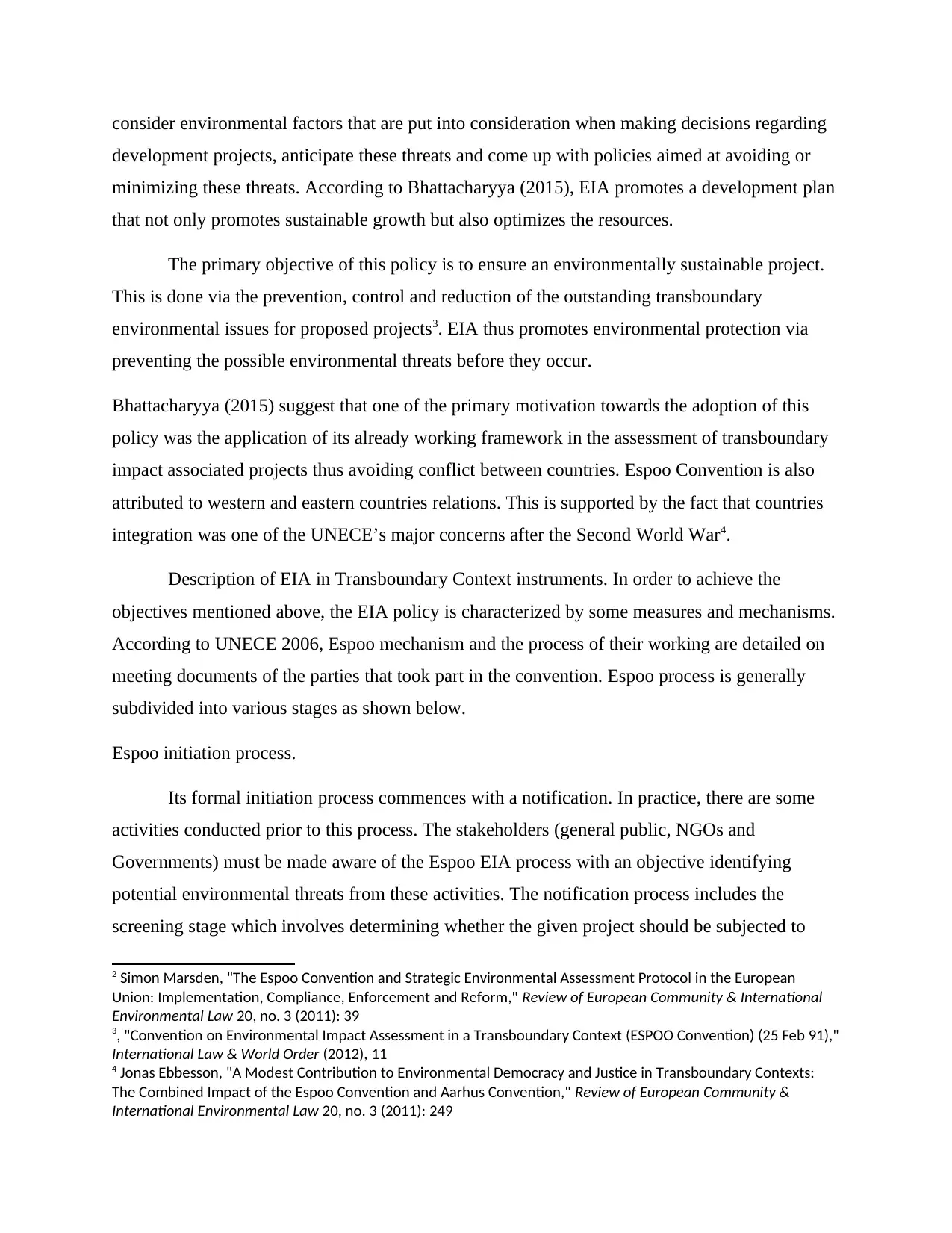
consider environmental factors that are put into consideration when making decisions regarding
development projects, anticipate these threats and come up with policies aimed at avoiding or
minimizing these threats. According to Bhattacharyya (2015), EIA promotes a development plan
that not only promotes sustainable growth but also optimizes the resources.
The primary objective of this policy is to ensure an environmentally sustainable project.
This is done via the prevention, control and reduction of the outstanding transboundary
environmental issues for proposed projects3. EIA thus promotes environmental protection via
preventing the possible environmental threats before they occur.
Bhattacharyya (2015) suggest that one of the primary motivation towards the adoption of this
policy was the application of its already working framework in the assessment of transboundary
impact associated projects thus avoiding conflict between countries. Espoo Convention is also
attributed to western and eastern countries relations. This is supported by the fact that countries
integration was one of the UNECE’s major concerns after the Second World War4.
Description of EIA in Transboundary Context instruments. In order to achieve the
objectives mentioned above, the EIA policy is characterized by some measures and mechanisms.
According to UNECE 2006, Espoo mechanism and the process of their working are detailed on
meeting documents of the parties that took part in the convention. Espoo process is generally
subdivided into various stages as shown below.
Espoo initiation process.
Its formal initiation process commences with a notification. In practice, there are some
activities conducted prior to this process. The stakeholders (general public, NGOs and
Governments) must be made aware of the Espoo EIA process with an objective identifying
potential environmental threats from these activities. The notification process includes the
screening stage which involves determining whether the given project should be subjected to
2 Simon Marsden, "The Espoo Convention and Strategic Environmental Assessment Protocol in the European
Union: Implementation, Compliance, Enforcement and Reform," Review of European Community & International
Environmental Law 20, no. 3 (2011): 39
3, "Convention on Environmental Impact Assessment in a Transboundary Context (ESPOO Convention) (25 Feb 91),"
International Law & World Order (2012), 11
4 Jonas Ebbesson, "A Modest Contribution to Environmental Democracy and Justice in Transboundary Contexts:
The Combined Impact of the Espoo Convention and Aarhus Convention," Review of European Community &
International Environmental Law 20, no. 3 (2011): 249
development projects, anticipate these threats and come up with policies aimed at avoiding or
minimizing these threats. According to Bhattacharyya (2015), EIA promotes a development plan
that not only promotes sustainable growth but also optimizes the resources.
The primary objective of this policy is to ensure an environmentally sustainable project.
This is done via the prevention, control and reduction of the outstanding transboundary
environmental issues for proposed projects3. EIA thus promotes environmental protection via
preventing the possible environmental threats before they occur.
Bhattacharyya (2015) suggest that one of the primary motivation towards the adoption of this
policy was the application of its already working framework in the assessment of transboundary
impact associated projects thus avoiding conflict between countries. Espoo Convention is also
attributed to western and eastern countries relations. This is supported by the fact that countries
integration was one of the UNECE’s major concerns after the Second World War4.
Description of EIA in Transboundary Context instruments. In order to achieve the
objectives mentioned above, the EIA policy is characterized by some measures and mechanisms.
According to UNECE 2006, Espoo mechanism and the process of their working are detailed on
meeting documents of the parties that took part in the convention. Espoo process is generally
subdivided into various stages as shown below.
Espoo initiation process.
Its formal initiation process commences with a notification. In practice, there are some
activities conducted prior to this process. The stakeholders (general public, NGOs and
Governments) must be made aware of the Espoo EIA process with an objective identifying
potential environmental threats from these activities. The notification process includes the
screening stage which involves determining whether the given project should be subjected to
2 Simon Marsden, "The Espoo Convention and Strategic Environmental Assessment Protocol in the European
Union: Implementation, Compliance, Enforcement and Reform," Review of European Community & International
Environmental Law 20, no. 3 (2011): 39
3, "Convention on Environmental Impact Assessment in a Transboundary Context (ESPOO Convention) (25 Feb 91),"
International Law & World Order (2012), 11
4 Jonas Ebbesson, "A Modest Contribution to Environmental Democracy and Justice in Transboundary Contexts:
The Combined Impact of the Espoo Convention and Aarhus Convention," Review of European Community &
International Environmental Law 20, no. 3 (2011): 249
⊘ This is a preview!⊘
Do you want full access?
Subscribe today to unlock all pages.

Trusted by 1+ million students worldwide
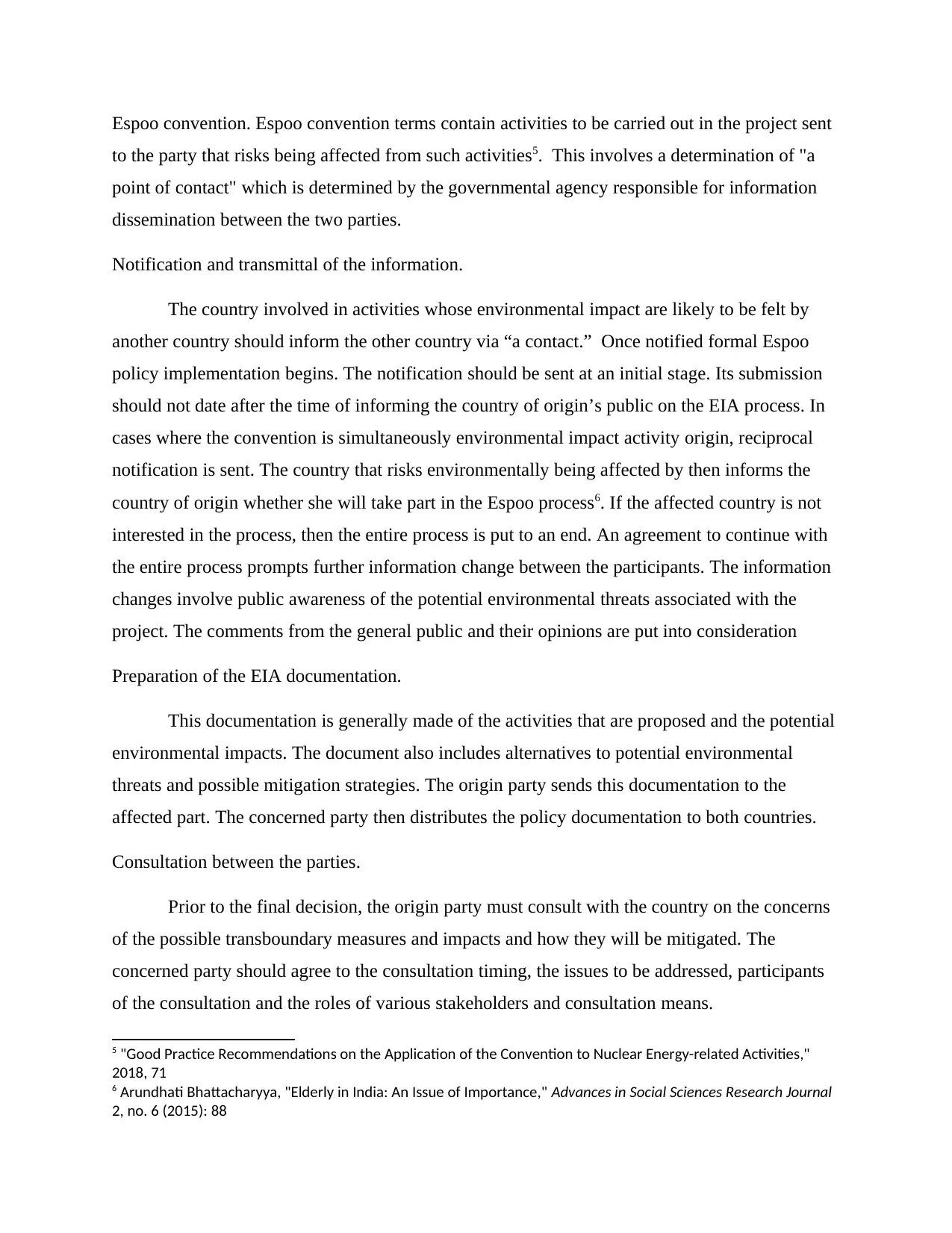
Espoo convention. Espoo convention terms contain activities to be carried out in the project sent
to the party that risks being affected from such activities5. This involves a determination of "a
point of contact" which is determined by the governmental agency responsible for information
dissemination between the two parties.
Notification and transmittal of the information.
The country involved in activities whose environmental impact are likely to be felt by
another country should inform the other country via “a contact.” Once notified formal Espoo
policy implementation begins. The notification should be sent at an initial stage. Its submission
should not date after the time of informing the country of origin’s public on the EIA process. In
cases where the convention is simultaneously environmental impact activity origin, reciprocal
notification is sent. The country that risks environmentally being affected by then informs the
country of origin whether she will take part in the Espoo process6. If the affected country is not
interested in the process, then the entire process is put to an end. An agreement to continue with
the entire process prompts further information change between the participants. The information
changes involve public awareness of the potential environmental threats associated with the
project. The comments from the general public and their opinions are put into consideration
Preparation of the EIA documentation.
This documentation is generally made of the activities that are proposed and the potential
environmental impacts. The document also includes alternatives to potential environmental
threats and possible mitigation strategies. The origin party sends this documentation to the
affected part. The concerned party then distributes the policy documentation to both countries.
Consultation between the parties.
Prior to the final decision, the origin party must consult with the country on the concerns
of the possible transboundary measures and impacts and how they will be mitigated. The
concerned party should agree to the consultation timing, the issues to be addressed, participants
of the consultation and the roles of various stakeholders and consultation means.
5 "Good Practice Recommendations on the Application of the Convention to Nuclear Energy-related Activities,"
2018, 71
6 Arundhati Bhattacharyya, "Elderly in India: An Issue of Importance," Advances in Social Sciences Research Journal
2, no. 6 (2015): 88
to the party that risks being affected from such activities5. This involves a determination of "a
point of contact" which is determined by the governmental agency responsible for information
dissemination between the two parties.
Notification and transmittal of the information.
The country involved in activities whose environmental impact are likely to be felt by
another country should inform the other country via “a contact.” Once notified formal Espoo
policy implementation begins. The notification should be sent at an initial stage. Its submission
should not date after the time of informing the country of origin’s public on the EIA process. In
cases where the convention is simultaneously environmental impact activity origin, reciprocal
notification is sent. The country that risks environmentally being affected by then informs the
country of origin whether she will take part in the Espoo process6. If the affected country is not
interested in the process, then the entire process is put to an end. An agreement to continue with
the entire process prompts further information change between the participants. The information
changes involve public awareness of the potential environmental threats associated with the
project. The comments from the general public and their opinions are put into consideration
Preparation of the EIA documentation.
This documentation is generally made of the activities that are proposed and the potential
environmental impacts. The document also includes alternatives to potential environmental
threats and possible mitigation strategies. The origin party sends this documentation to the
affected part. The concerned party then distributes the policy documentation to both countries.
Consultation between the parties.
Prior to the final decision, the origin party must consult with the country on the concerns
of the possible transboundary measures and impacts and how they will be mitigated. The
concerned party should agree to the consultation timing, the issues to be addressed, participants
of the consultation and the roles of various stakeholders and consultation means.
5 "Good Practice Recommendations on the Application of the Convention to Nuclear Energy-related Activities,"
2018, 71
6 Arundhati Bhattacharyya, "Elderly in India: An Issue of Importance," Advances in Social Sciences Research Journal
2, no. 6 (2015): 88
Paraphrase This Document
Need a fresh take? Get an instant paraphrase of this document with our AI Paraphraser
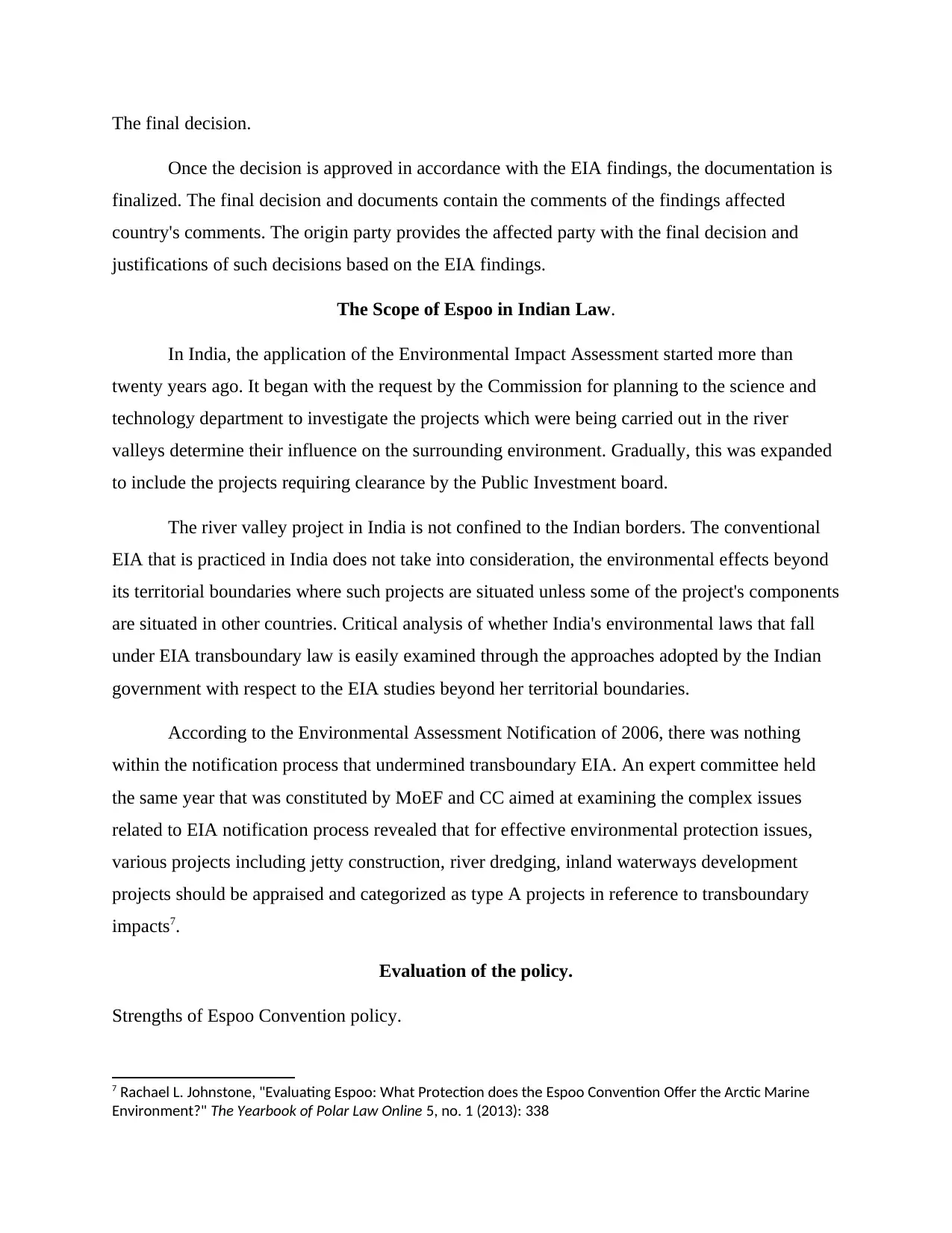
The final decision.
Once the decision is approved in accordance with the EIA findings, the documentation is
finalized. The final decision and documents contain the comments of the findings affected
country's comments. The origin party provides the affected party with the final decision and
justifications of such decisions based on the EIA findings.
The Scope of Espoo in Indian Law.
In India, the application of the Environmental Impact Assessment started more than
twenty years ago. It began with the request by the Commission for planning to the science and
technology department to investigate the projects which were being carried out in the river
valleys determine their influence on the surrounding environment. Gradually, this was expanded
to include the projects requiring clearance by the Public Investment board.
The river valley project in India is not confined to the Indian borders. The conventional
EIA that is practiced in India does not take into consideration, the environmental effects beyond
its territorial boundaries where such projects are situated unless some of the project's components
are situated in other countries. Critical analysis of whether India's environmental laws that fall
under EIA transboundary law is easily examined through the approaches adopted by the Indian
government with respect to the EIA studies beyond her territorial boundaries.
According to the Environmental Assessment Notification of 2006, there was nothing
within the notification process that undermined transboundary EIA. An expert committee held
the same year that was constituted by MoEF and CC aimed at examining the complex issues
related to EIA notification process revealed that for effective environmental protection issues,
various projects including jetty construction, river dredging, inland waterways development
projects should be appraised and categorized as type A projects in reference to transboundary
impacts7.
Evaluation of the policy.
Strengths of Espoo Convention policy.
7 Rachael L. Johnstone, "Evaluating Espoo: What Protection does the Espoo Convention Offer the Arctic Marine
Environment?" The Yearbook of Polar Law Online 5, no. 1 (2013): 338
Once the decision is approved in accordance with the EIA findings, the documentation is
finalized. The final decision and documents contain the comments of the findings affected
country's comments. The origin party provides the affected party with the final decision and
justifications of such decisions based on the EIA findings.
The Scope of Espoo in Indian Law.
In India, the application of the Environmental Impact Assessment started more than
twenty years ago. It began with the request by the Commission for planning to the science and
technology department to investigate the projects which were being carried out in the river
valleys determine their influence on the surrounding environment. Gradually, this was expanded
to include the projects requiring clearance by the Public Investment board.
The river valley project in India is not confined to the Indian borders. The conventional
EIA that is practiced in India does not take into consideration, the environmental effects beyond
its territorial boundaries where such projects are situated unless some of the project's components
are situated in other countries. Critical analysis of whether India's environmental laws that fall
under EIA transboundary law is easily examined through the approaches adopted by the Indian
government with respect to the EIA studies beyond her territorial boundaries.
According to the Environmental Assessment Notification of 2006, there was nothing
within the notification process that undermined transboundary EIA. An expert committee held
the same year that was constituted by MoEF and CC aimed at examining the complex issues
related to EIA notification process revealed that for effective environmental protection issues,
various projects including jetty construction, river dredging, inland waterways development
projects should be appraised and categorized as type A projects in reference to transboundary
impacts7.
Evaluation of the policy.
Strengths of Espoo Convention policy.
7 Rachael L. Johnstone, "Evaluating Espoo: What Protection does the Espoo Convention Offer the Arctic Marine
Environment?" The Yearbook of Polar Law Online 5, no. 1 (2013): 338
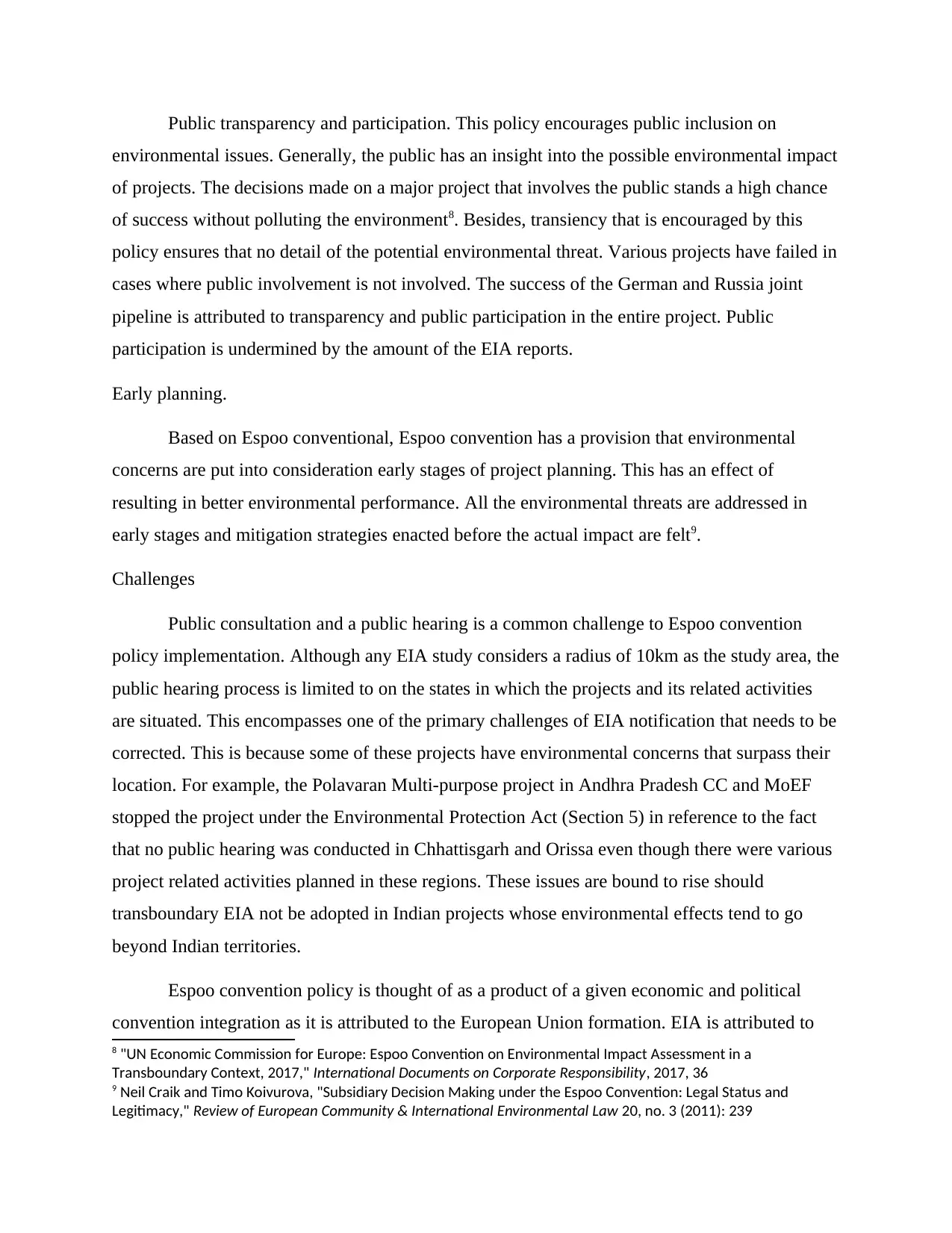
Public transparency and participation. This policy encourages public inclusion on
environmental issues. Generally, the public has an insight into the possible environmental impact
of projects. The decisions made on a major project that involves the public stands a high chance
of success without polluting the environment8. Besides, transiency that is encouraged by this
policy ensures that no detail of the potential environmental threat. Various projects have failed in
cases where public involvement is not involved. The success of the German and Russia joint
pipeline is attributed to transparency and public participation in the entire project. Public
participation is undermined by the amount of the EIA reports.
Early planning.
Based on Espoo conventional, Espoo convention has a provision that environmental
concerns are put into consideration early stages of project planning. This has an effect of
resulting in better environmental performance. All the environmental threats are addressed in
early stages and mitigation strategies enacted before the actual impact are felt9.
Challenges
Public consultation and a public hearing is a common challenge to Espoo convention
policy implementation. Although any EIA study considers a radius of 10km as the study area, the
public hearing process is limited to on the states in which the projects and its related activities
are situated. This encompasses one of the primary challenges of EIA notification that needs to be
corrected. This is because some of these projects have environmental concerns that surpass their
location. For example, the Polavaran Multi-purpose project in Andhra Pradesh CC and MoEF
stopped the project under the Environmental Protection Act (Section 5) in reference to the fact
that no public hearing was conducted in Chhattisgarh and Orissa even though there were various
project related activities planned in these regions. These issues are bound to rise should
transboundary EIA not be adopted in Indian projects whose environmental effects tend to go
beyond Indian territories.
Espoo convention policy is thought of as a product of a given economic and political
convention integration as it is attributed to the European Union formation. EIA is attributed to
8 "UN Economic Commission for Europe: Espoo Convention on Environmental Impact Assessment in a
Transboundary Context, 2017," International Documents on Corporate Responsibility, 2017, 36
9 Neil Craik and Timo Koivurova, "Subsidiary Decision Making under the Espoo Convention: Legal Status and
Legitimacy," Review of European Community & International Environmental Law 20, no. 3 (2011): 239
environmental issues. Generally, the public has an insight into the possible environmental impact
of projects. The decisions made on a major project that involves the public stands a high chance
of success without polluting the environment8. Besides, transiency that is encouraged by this
policy ensures that no detail of the potential environmental threat. Various projects have failed in
cases where public involvement is not involved. The success of the German and Russia joint
pipeline is attributed to transparency and public participation in the entire project. Public
participation is undermined by the amount of the EIA reports.
Early planning.
Based on Espoo conventional, Espoo convention has a provision that environmental
concerns are put into consideration early stages of project planning. This has an effect of
resulting in better environmental performance. All the environmental threats are addressed in
early stages and mitigation strategies enacted before the actual impact are felt9.
Challenges
Public consultation and a public hearing is a common challenge to Espoo convention
policy implementation. Although any EIA study considers a radius of 10km as the study area, the
public hearing process is limited to on the states in which the projects and its related activities
are situated. This encompasses one of the primary challenges of EIA notification that needs to be
corrected. This is because some of these projects have environmental concerns that surpass their
location. For example, the Polavaran Multi-purpose project in Andhra Pradesh CC and MoEF
stopped the project under the Environmental Protection Act (Section 5) in reference to the fact
that no public hearing was conducted in Chhattisgarh and Orissa even though there were various
project related activities planned in these regions. These issues are bound to rise should
transboundary EIA not be adopted in Indian projects whose environmental effects tend to go
beyond Indian territories.
Espoo convention policy is thought of as a product of a given economic and political
convention integration as it is attributed to the European Union formation. EIA is attributed to
8 "UN Economic Commission for Europe: Espoo Convention on Environmental Impact Assessment in a
Transboundary Context, 2017," International Documents on Corporate Responsibility, 2017, 36
9 Neil Craik and Timo Koivurova, "Subsidiary Decision Making under the Espoo Convention: Legal Status and
Legitimacy," Review of European Community & International Environmental Law 20, no. 3 (2011): 239
⊘ This is a preview!⊘
Do you want full access?
Subscribe today to unlock all pages.

Trusted by 1+ million students worldwide
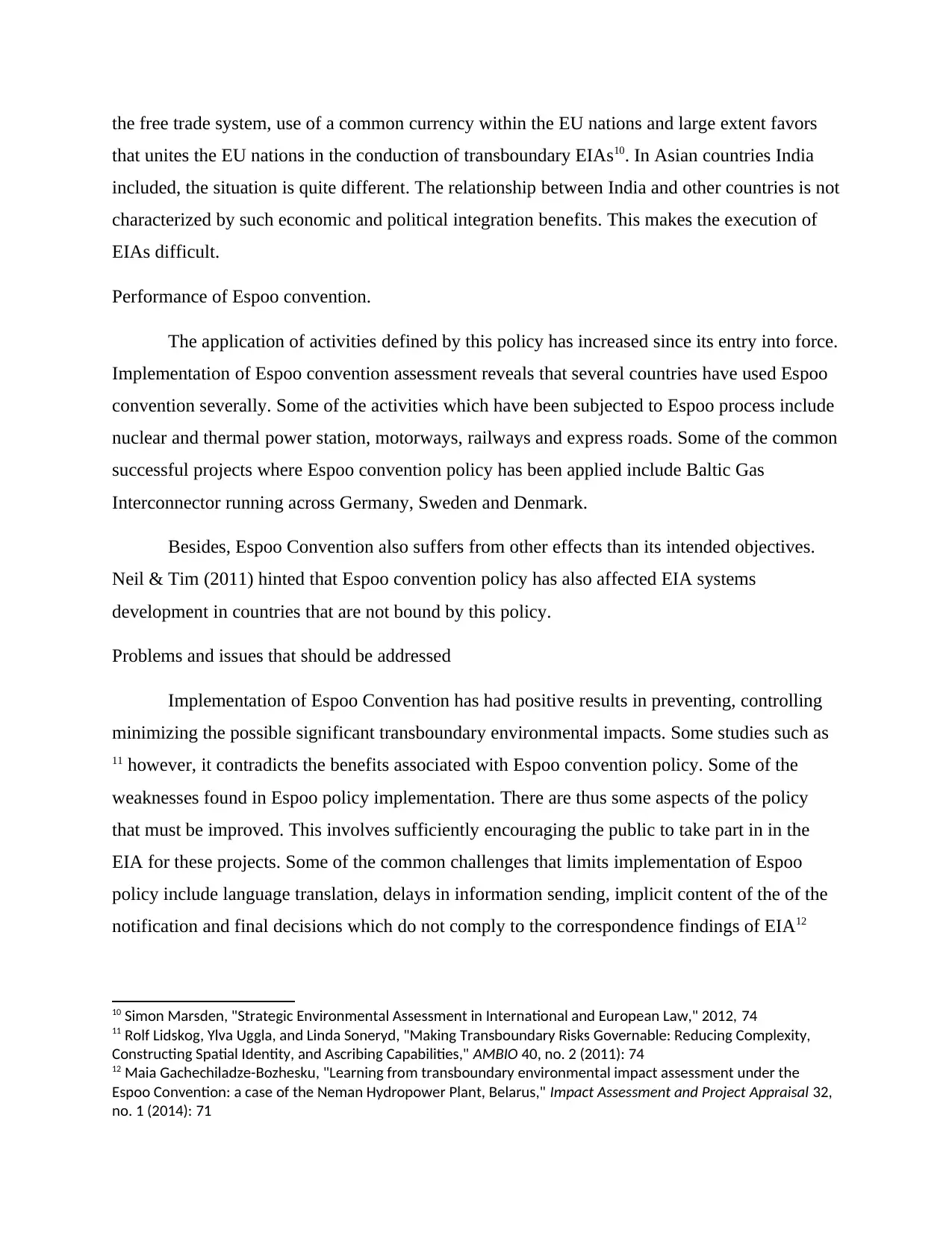
the free trade system, use of a common currency within the EU nations and large extent favors
that unites the EU nations in the conduction of transboundary EIAs10. In Asian countries India
included, the situation is quite different. The relationship between India and other countries is not
characterized by such economic and political integration benefits. This makes the execution of
EIAs difficult.
Performance of Espoo convention.
The application of activities defined by this policy has increased since its entry into force.
Implementation of Espoo convention assessment reveals that several countries have used Espoo
convention severally. Some of the activities which have been subjected to Espoo process include
nuclear and thermal power station, motorways, railways and express roads. Some of the common
successful projects where Espoo convention policy has been applied include Baltic Gas
Interconnector running across Germany, Sweden and Denmark.
Besides, Espoo Convention also suffers from other effects than its intended objectives.
Neil & Tim (2011) hinted that Espoo convention policy has also affected EIA systems
development in countries that are not bound by this policy.
Problems and issues that should be addressed
Implementation of Espoo Convention has had positive results in preventing, controlling
minimizing the possible significant transboundary environmental impacts. Some studies such as
11 however, it contradicts the benefits associated with Espoo convention policy. Some of the
weaknesses found in Espoo policy implementation. There are thus some aspects of the policy
that must be improved. This involves sufficiently encouraging the public to take part in in the
EIA for these projects. Some of the common challenges that limits implementation of Espoo
policy include language translation, delays in information sending, implicit content of the of the
notification and final decisions which do not comply to the correspondence findings of EIA12
10 Simon Marsden, "Strategic Environmental Assessment in International and European Law," 2012, 74
11 Rolf Lidskog, Ylva Uggla, and Linda Soneryd, "Making Transboundary Risks Governable: Reducing Complexity,
Constructing Spatial Identity, and Ascribing Capabilities," AMBIO 40, no. 2 (2011): 74
12 Maia Gachechiladze-Bozhesku, "Learning from transboundary environmental impact assessment under the
Espoo Convention: a case of the Neman Hydropower Plant, Belarus," Impact Assessment and Project Appraisal 32,
no. 1 (2014): 71
that unites the EU nations in the conduction of transboundary EIAs10. In Asian countries India
included, the situation is quite different. The relationship between India and other countries is not
characterized by such economic and political integration benefits. This makes the execution of
EIAs difficult.
Performance of Espoo convention.
The application of activities defined by this policy has increased since its entry into force.
Implementation of Espoo convention assessment reveals that several countries have used Espoo
convention severally. Some of the activities which have been subjected to Espoo process include
nuclear and thermal power station, motorways, railways and express roads. Some of the common
successful projects where Espoo convention policy has been applied include Baltic Gas
Interconnector running across Germany, Sweden and Denmark.
Besides, Espoo Convention also suffers from other effects than its intended objectives.
Neil & Tim (2011) hinted that Espoo convention policy has also affected EIA systems
development in countries that are not bound by this policy.
Problems and issues that should be addressed
Implementation of Espoo Convention has had positive results in preventing, controlling
minimizing the possible significant transboundary environmental impacts. Some studies such as
11 however, it contradicts the benefits associated with Espoo convention policy. Some of the
weaknesses found in Espoo policy implementation. There are thus some aspects of the policy
that must be improved. This involves sufficiently encouraging the public to take part in in the
EIA for these projects. Some of the common challenges that limits implementation of Espoo
policy include language translation, delays in information sending, implicit content of the of the
notification and final decisions which do not comply to the correspondence findings of EIA12
10 Simon Marsden, "Strategic Environmental Assessment in International and European Law," 2012, 74
11 Rolf Lidskog, Ylva Uggla, and Linda Soneryd, "Making Transboundary Risks Governable: Reducing Complexity,
Constructing Spatial Identity, and Ascribing Capabilities," AMBIO 40, no. 2 (2011): 74
12 Maia Gachechiladze-Bozhesku, "Learning from transboundary environmental impact assessment under the
Espoo Convention: a case of the Neman Hydropower Plant, Belarus," Impact Assessment and Project Appraisal 32,
no. 1 (2014): 71
Paraphrase This Document
Need a fresh take? Get an instant paraphrase of this document with our AI Paraphraser
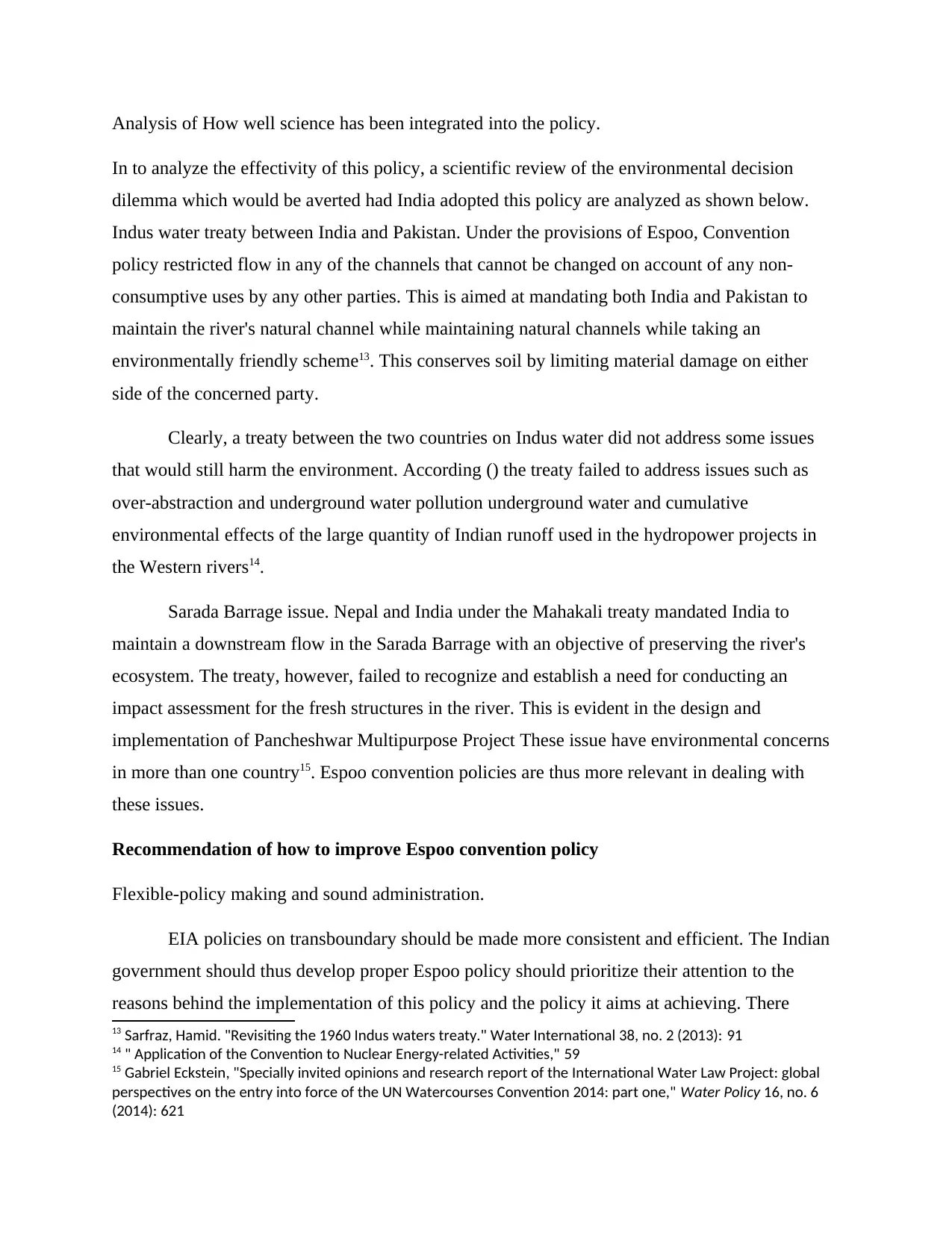
Analysis of How well science has been integrated into the policy.
In to analyze the effectivity of this policy, a scientific review of the environmental decision
dilemma which would be averted had India adopted this policy are analyzed as shown below.
Indus water treaty between India and Pakistan. Under the provisions of Espoo, Convention
policy restricted flow in any of the channels that cannot be changed on account of any non-
consumptive uses by any other parties. This is aimed at mandating both India and Pakistan to
maintain the river's natural channel while maintaining natural channels while taking an
environmentally friendly scheme13. This conserves soil by limiting material damage on either
side of the concerned party.
Clearly, a treaty between the two countries on Indus water did not address some issues
that would still harm the environment. According () the treaty failed to address issues such as
over-abstraction and underground water pollution underground water and cumulative
environmental effects of the large quantity of Indian runoff used in the hydropower projects in
the Western rivers14.
Sarada Barrage issue. Nepal and India under the Mahakali treaty mandated India to
maintain a downstream flow in the Sarada Barrage with an objective of preserving the river's
ecosystem. The treaty, however, failed to recognize and establish a need for conducting an
impact assessment for the fresh structures in the river. This is evident in the design and
implementation of Pancheshwar Multipurpose Project These issue have environmental concerns
in more than one country15. Espoo convention policies are thus more relevant in dealing with
these issues.
Recommendation of how to improve Espoo convention policy
Flexible-policy making and sound administration.
EIA policies on transboundary should be made more consistent and efficient. The Indian
government should thus develop proper Espoo policy should prioritize their attention to the
reasons behind the implementation of this policy and the policy it aims at achieving. There
13 Sarfraz, Hamid. "Revisiting the 1960 Indus waters treaty." Water International 38, no. 2 (2013): 91
14 " Application of the Convention to Nuclear Energy-related Activities," 59
15 Gabriel Eckstein, "Specially invited opinions and research report of the International Water Law Project: global
perspectives on the entry into force of the UN Watercourses Convention 2014: part one," Water Policy 16, no. 6
(2014): 621
In to analyze the effectivity of this policy, a scientific review of the environmental decision
dilemma which would be averted had India adopted this policy are analyzed as shown below.
Indus water treaty between India and Pakistan. Under the provisions of Espoo, Convention
policy restricted flow in any of the channels that cannot be changed on account of any non-
consumptive uses by any other parties. This is aimed at mandating both India and Pakistan to
maintain the river's natural channel while maintaining natural channels while taking an
environmentally friendly scheme13. This conserves soil by limiting material damage on either
side of the concerned party.
Clearly, a treaty between the two countries on Indus water did not address some issues
that would still harm the environment. According () the treaty failed to address issues such as
over-abstraction and underground water pollution underground water and cumulative
environmental effects of the large quantity of Indian runoff used in the hydropower projects in
the Western rivers14.
Sarada Barrage issue. Nepal and India under the Mahakali treaty mandated India to
maintain a downstream flow in the Sarada Barrage with an objective of preserving the river's
ecosystem. The treaty, however, failed to recognize and establish a need for conducting an
impact assessment for the fresh structures in the river. This is evident in the design and
implementation of Pancheshwar Multipurpose Project These issue have environmental concerns
in more than one country15. Espoo convention policies are thus more relevant in dealing with
these issues.
Recommendation of how to improve Espoo convention policy
Flexible-policy making and sound administration.
EIA policies on transboundary should be made more consistent and efficient. The Indian
government should thus develop proper Espoo policy should prioritize their attention to the
reasons behind the implementation of this policy and the policy it aims at achieving. There
13 Sarfraz, Hamid. "Revisiting the 1960 Indus waters treaty." Water International 38, no. 2 (2013): 91
14 " Application of the Convention to Nuclear Energy-related Activities," 59
15 Gabriel Eckstein, "Specially invited opinions and research report of the International Water Law Project: global
perspectives on the entry into force of the UN Watercourses Convention 2014: part one," Water Policy 16, no. 6
(2014): 621
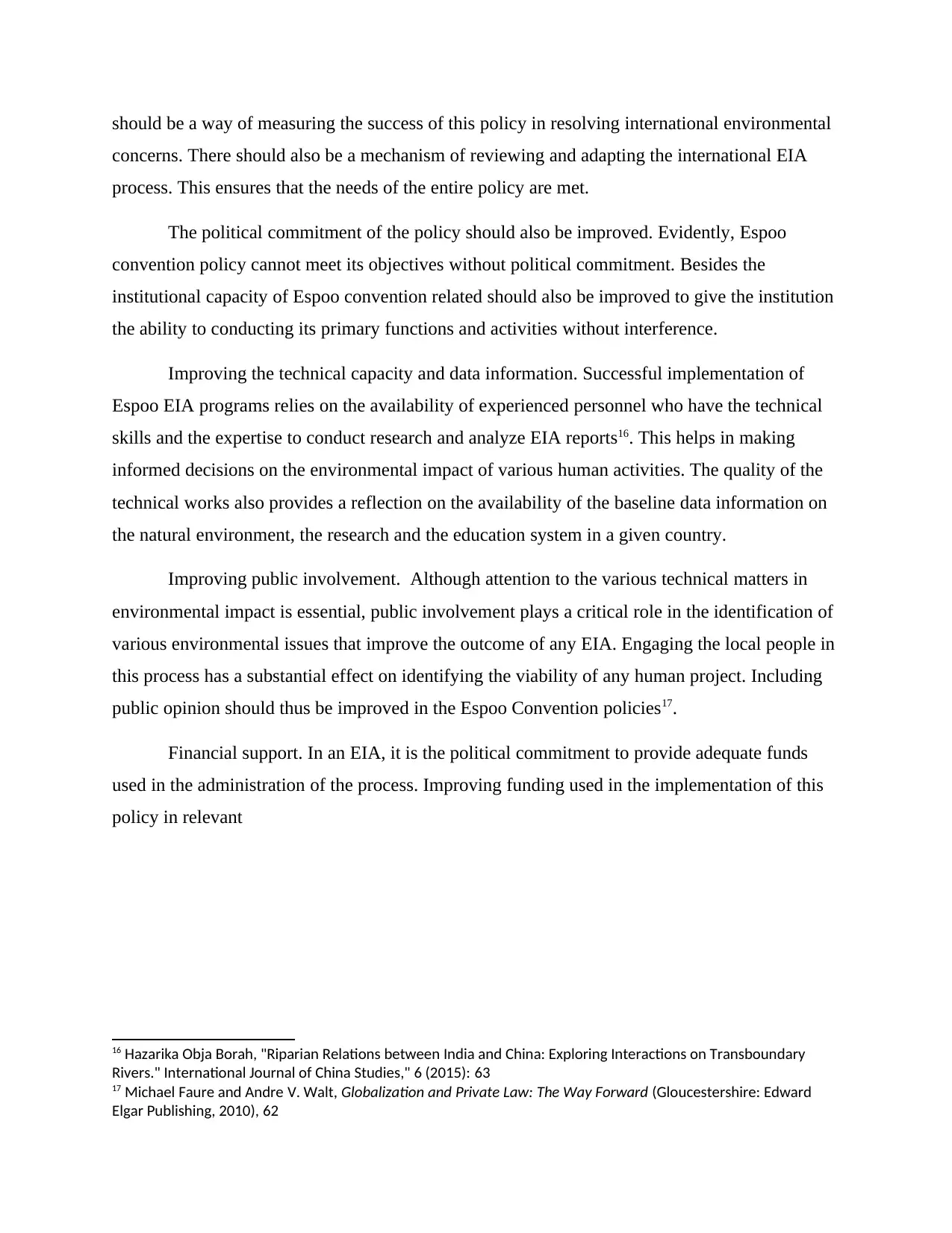
should be a way of measuring the success of this policy in resolving international environmental
concerns. There should also be a mechanism of reviewing and adapting the international EIA
process. This ensures that the needs of the entire policy are met.
The political commitment of the policy should also be improved. Evidently, Espoo
convention policy cannot meet its objectives without political commitment. Besides the
institutional capacity of Espoo convention related should also be improved to give the institution
the ability to conducting its primary functions and activities without interference.
Improving the technical capacity and data information. Successful implementation of
Espoo EIA programs relies on the availability of experienced personnel who have the technical
skills and the expertise to conduct research and analyze EIA reports16. This helps in making
informed decisions on the environmental impact of various human activities. The quality of the
technical works also provides a reflection on the availability of the baseline data information on
the natural environment, the research and the education system in a given country.
Improving public involvement. Although attention to the various technical matters in
environmental impact is essential, public involvement plays a critical role in the identification of
various environmental issues that improve the outcome of any EIA. Engaging the local people in
this process has a substantial effect on identifying the viability of any human project. Including
public opinion should thus be improved in the Espoo Convention policies17.
Financial support. In an EIA, it is the political commitment to provide adequate funds
used in the administration of the process. Improving funding used in the implementation of this
policy in relevant
16 Hazarika Obja Borah, "Riparian Relations between India and China: Exploring Interactions on Transboundary
Rivers." International Journal of China Studies," 6 (2015): 63
17 Michael Faure and Andre V. Walt, Globalization and Private Law: The Way Forward (Gloucestershire: Edward
Elgar Publishing, 2010), 62
concerns. There should also be a mechanism of reviewing and adapting the international EIA
process. This ensures that the needs of the entire policy are met.
The political commitment of the policy should also be improved. Evidently, Espoo
convention policy cannot meet its objectives without political commitment. Besides the
institutional capacity of Espoo convention related should also be improved to give the institution
the ability to conducting its primary functions and activities without interference.
Improving the technical capacity and data information. Successful implementation of
Espoo EIA programs relies on the availability of experienced personnel who have the technical
skills and the expertise to conduct research and analyze EIA reports16. This helps in making
informed decisions on the environmental impact of various human activities. The quality of the
technical works also provides a reflection on the availability of the baseline data information on
the natural environment, the research and the education system in a given country.
Improving public involvement. Although attention to the various technical matters in
environmental impact is essential, public involvement plays a critical role in the identification of
various environmental issues that improve the outcome of any EIA. Engaging the local people in
this process has a substantial effect on identifying the viability of any human project. Including
public opinion should thus be improved in the Espoo Convention policies17.
Financial support. In an EIA, it is the political commitment to provide adequate funds
used in the administration of the process. Improving funding used in the implementation of this
policy in relevant
16 Hazarika Obja Borah, "Riparian Relations between India and China: Exploring Interactions on Transboundary
Rivers." International Journal of China Studies," 6 (2015): 63
17 Michael Faure and Andre V. Walt, Globalization and Private Law: The Way Forward (Gloucestershire: Edward
Elgar Publishing, 2010), 62
⊘ This is a preview!⊘
Do you want full access?
Subscribe today to unlock all pages.

Trusted by 1+ million students worldwide
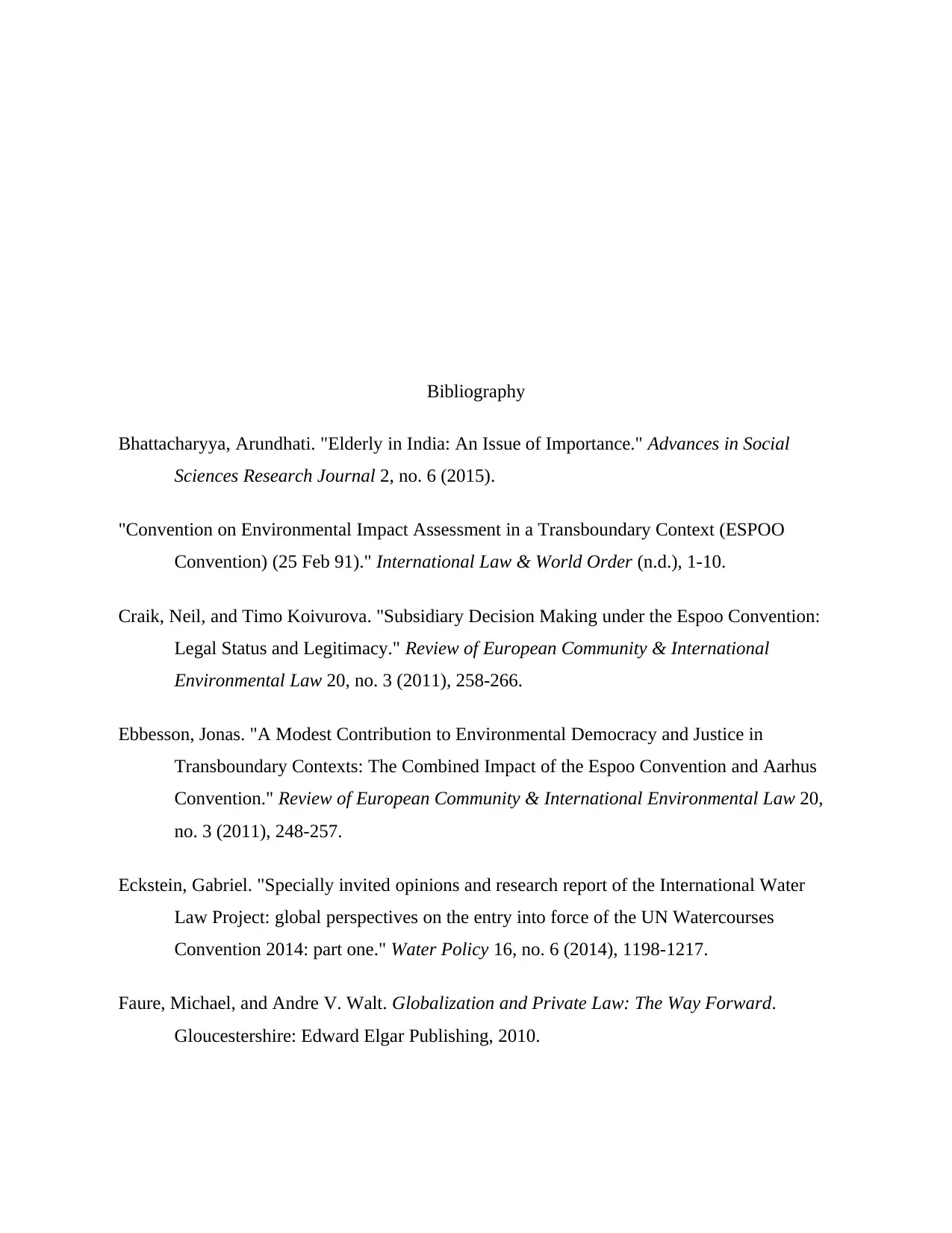
Bibliography
Bhattacharyya, Arundhati. "Elderly in India: An Issue of Importance." Advances in Social
Sciences Research Journal 2, no. 6 (2015).
"Convention on Environmental Impact Assessment in a Transboundary Context (ESPOO
Convention) (25 Feb 91)." International Law & World Order (n.d.), 1-10.
Craik, Neil, and Timo Koivurova. "Subsidiary Decision Making under the Espoo Convention:
Legal Status and Legitimacy." Review of European Community & International
Environmental Law 20, no. 3 (2011), 258-266.
Ebbesson, Jonas. "A Modest Contribution to Environmental Democracy and Justice in
Transboundary Contexts: The Combined Impact of the Espoo Convention and Aarhus
Convention." Review of European Community & International Environmental Law 20,
no. 3 (2011), 248-257.
Eckstein, Gabriel. "Specially invited opinions and research report of the International Water
Law Project: global perspectives on the entry into force of the UN Watercourses
Convention 2014: part one." Water Policy 16, no. 6 (2014), 1198-1217.
Faure, Michael, and Andre V. Walt. Globalization and Private Law: The Way Forward.
Gloucestershire: Edward Elgar Publishing, 2010.
Bhattacharyya, Arundhati. "Elderly in India: An Issue of Importance." Advances in Social
Sciences Research Journal 2, no. 6 (2015).
"Convention on Environmental Impact Assessment in a Transboundary Context (ESPOO
Convention) (25 Feb 91)." International Law & World Order (n.d.), 1-10.
Craik, Neil, and Timo Koivurova. "Subsidiary Decision Making under the Espoo Convention:
Legal Status and Legitimacy." Review of European Community & International
Environmental Law 20, no. 3 (2011), 258-266.
Ebbesson, Jonas. "A Modest Contribution to Environmental Democracy and Justice in
Transboundary Contexts: The Combined Impact of the Espoo Convention and Aarhus
Convention." Review of European Community & International Environmental Law 20,
no. 3 (2011), 248-257.
Eckstein, Gabriel. "Specially invited opinions and research report of the International Water
Law Project: global perspectives on the entry into force of the UN Watercourses
Convention 2014: part one." Water Policy 16, no. 6 (2014), 1198-1217.
Faure, Michael, and Andre V. Walt. Globalization and Private Law: The Way Forward.
Gloucestershire: Edward Elgar Publishing, 2010.
Paraphrase This Document
Need a fresh take? Get an instant paraphrase of this document with our AI Paraphraser
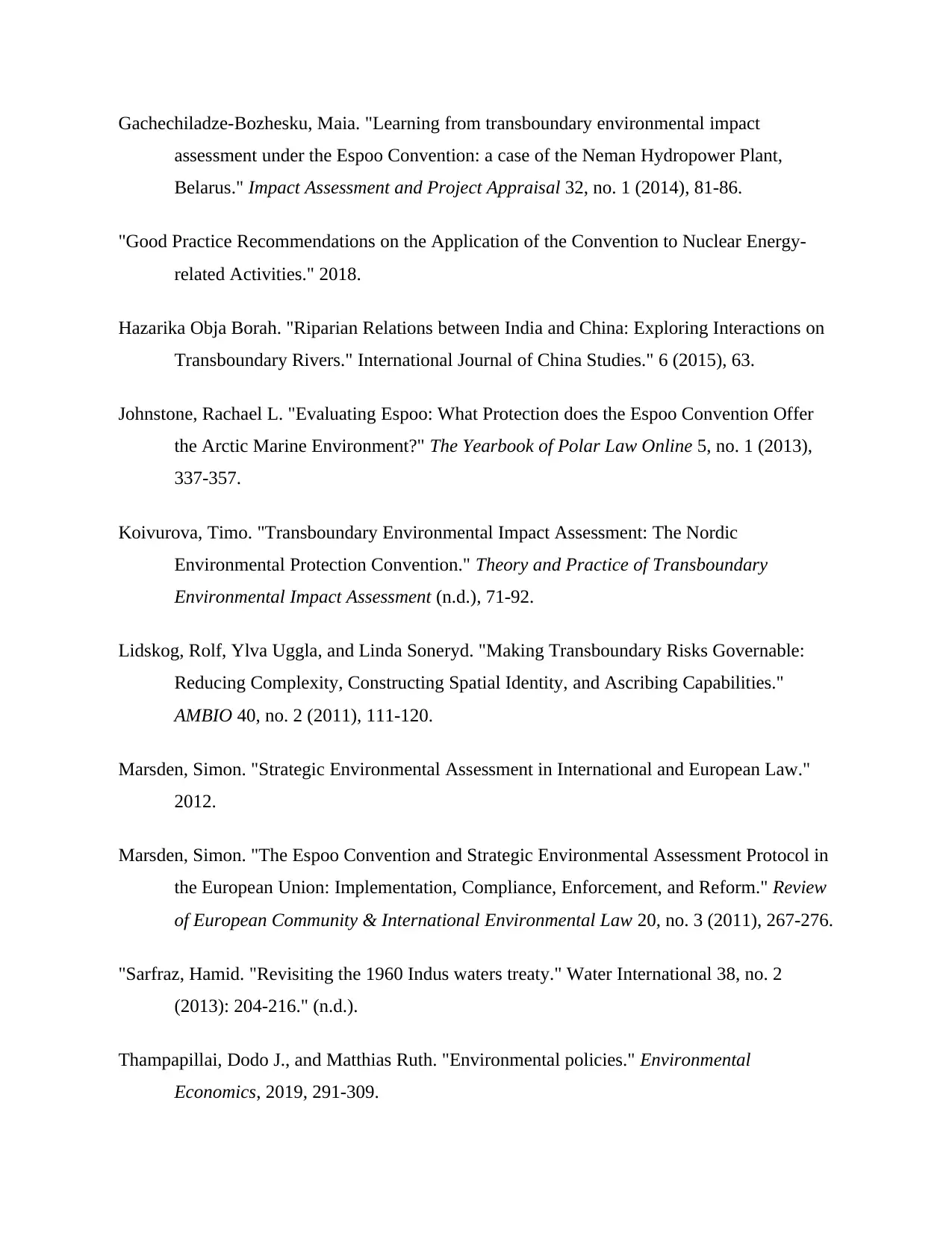
Gachechiladze-Bozhesku, Maia. "Learning from transboundary environmental impact
assessment under the Espoo Convention: a case of the Neman Hydropower Plant,
Belarus." Impact Assessment and Project Appraisal 32, no. 1 (2014), 81-86.
"Good Practice Recommendations on the Application of the Convention to Nuclear Energy-
related Activities." 2018.
Hazarika Obja Borah. "Riparian Relations between India and China: Exploring Interactions on
Transboundary Rivers." International Journal of China Studies." 6 (2015), 63.
Johnstone, Rachael L. "Evaluating Espoo: What Protection does the Espoo Convention Offer
the Arctic Marine Environment?" The Yearbook of Polar Law Online 5, no. 1 (2013),
337-357.
Koivurova, Timo. "Transboundary Environmental Impact Assessment: The Nordic
Environmental Protection Convention." Theory and Practice of Transboundary
Environmental Impact Assessment (n.d.), 71-92.
Lidskog, Rolf, Ylva Uggla, and Linda Soneryd. "Making Transboundary Risks Governable:
Reducing Complexity, Constructing Spatial Identity, and Ascribing Capabilities."
AMBIO 40, no. 2 (2011), 111-120.
Marsden, Simon. "Strategic Environmental Assessment in International and European Law."
2012.
Marsden, Simon. "The Espoo Convention and Strategic Environmental Assessment Protocol in
the European Union: Implementation, Compliance, Enforcement, and Reform." Review
of European Community & International Environmental Law 20, no. 3 (2011), 267-276.
"Sarfraz, Hamid. "Revisiting the 1960 Indus waters treaty." Water International 38, no. 2
(2013): 204-216." (n.d.).
Thampapillai, Dodo J., and Matthias Ruth. "Environmental policies." Environmental
Economics, 2019, 291-309.
assessment under the Espoo Convention: a case of the Neman Hydropower Plant,
Belarus." Impact Assessment and Project Appraisal 32, no. 1 (2014), 81-86.
"Good Practice Recommendations on the Application of the Convention to Nuclear Energy-
related Activities." 2018.
Hazarika Obja Borah. "Riparian Relations between India and China: Exploring Interactions on
Transboundary Rivers." International Journal of China Studies." 6 (2015), 63.
Johnstone, Rachael L. "Evaluating Espoo: What Protection does the Espoo Convention Offer
the Arctic Marine Environment?" The Yearbook of Polar Law Online 5, no. 1 (2013),
337-357.
Koivurova, Timo. "Transboundary Environmental Impact Assessment: The Nordic
Environmental Protection Convention." Theory and Practice of Transboundary
Environmental Impact Assessment (n.d.), 71-92.
Lidskog, Rolf, Ylva Uggla, and Linda Soneryd. "Making Transboundary Risks Governable:
Reducing Complexity, Constructing Spatial Identity, and Ascribing Capabilities."
AMBIO 40, no. 2 (2011), 111-120.
Marsden, Simon. "Strategic Environmental Assessment in International and European Law."
2012.
Marsden, Simon. "The Espoo Convention and Strategic Environmental Assessment Protocol in
the European Union: Implementation, Compliance, Enforcement, and Reform." Review
of European Community & International Environmental Law 20, no. 3 (2011), 267-276.
"Sarfraz, Hamid. "Revisiting the 1960 Indus waters treaty." Water International 38, no. 2
(2013): 204-216." (n.d.).
Thampapillai, Dodo J., and Matthias Ruth. "Environmental policies." Environmental
Economics, 2019, 291-309.
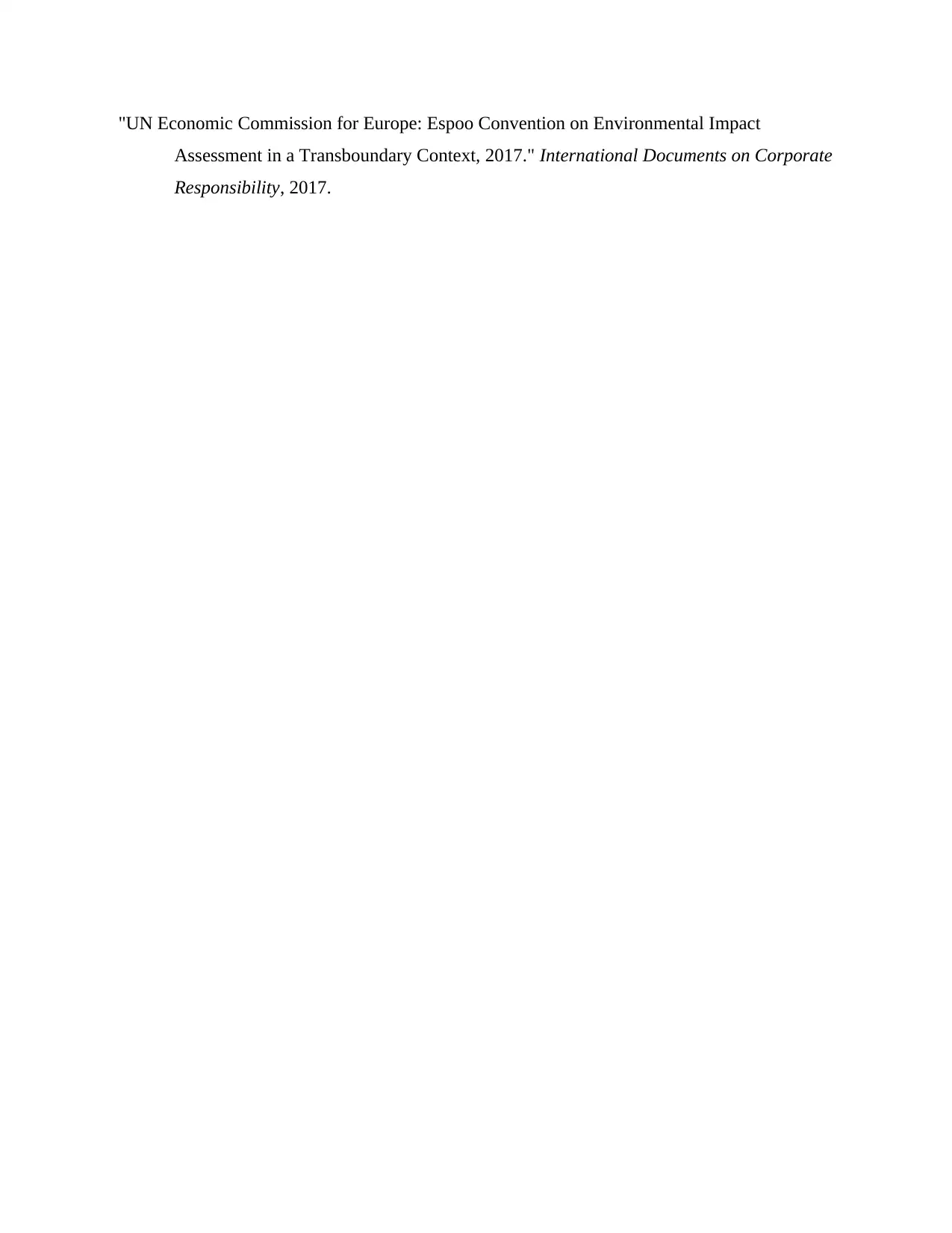
"UN Economic Commission for Europe: Espoo Convention on Environmental Impact
Assessment in a Transboundary Context, 2017." International Documents on Corporate
Responsibility, 2017.
Assessment in a Transboundary Context, 2017." International Documents on Corporate
Responsibility, 2017.
⊘ This is a preview!⊘
Do you want full access?
Subscribe today to unlock all pages.

Trusted by 1+ million students worldwide
1 out of 12
Related Documents
Your All-in-One AI-Powered Toolkit for Academic Success.
+13062052269
info@desklib.com
Available 24*7 on WhatsApp / Email
![[object Object]](/_next/static/media/star-bottom.7253800d.svg)
Unlock your academic potential
Copyright © 2020–2025 A2Z Services. All Rights Reserved. Developed and managed by ZUCOL.





